These are the top 10 best foods to eat, and the 10 foods to avoid for optimum health.
Just begin by giving up ONE at a time, then move on to the next one in the chart. Baby steps ensure you continue to make progress.
To make it even easier, there is a FREE printable for your fridge—it’s the perfect reminder to stay on track.
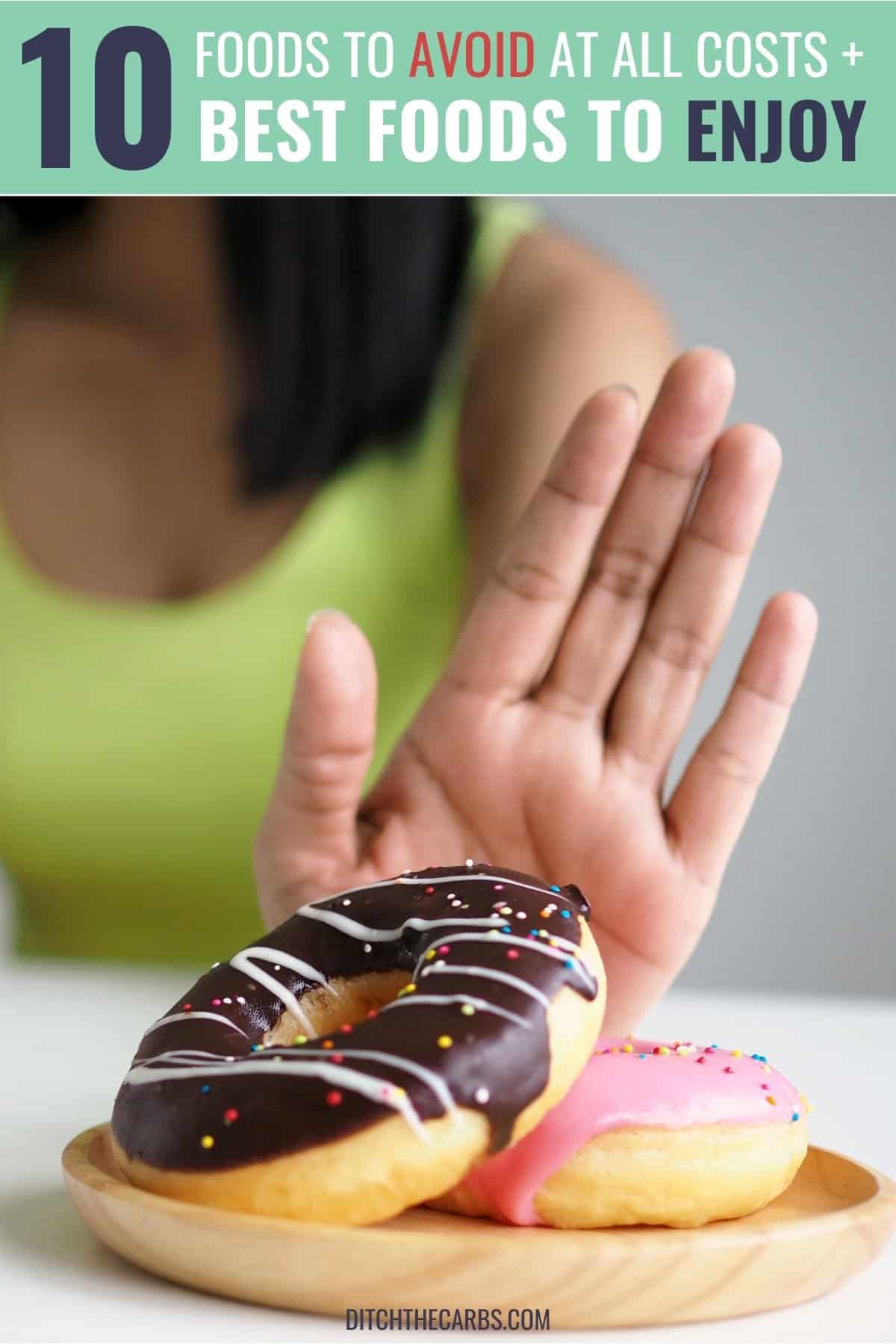
If you want to stay away from chronic inflammation, heart disease, obesity, and many other deliberating conditions, pay close attention!
Are you ready to lose weight and heal your body for life (without dieting, drugs, or making yourself miserable)?

Our free on-demand video training will walk you through how to make this THE year you set health goals…and keep them.
10 Foods to avoid (and their healthier alternatives)
We’re going to start with the bad guys first. There are a lot of foods out there that can derail your healthy lifestyle. Some of them are more obvious while others tend to be a bit more sneaky.
For optimum health, I suggest avoiding these 10 foods at all costs—they aren’t even worth consuming in small amounts.
1. Sodas and Soft Drinks
These beverages are at the top of my list because they have absolutely ZERO nutrition. They spike blood glucose. They trigger sugar cravings. They trigger hunger. They cause insulin resistance and hyperinsulinemia. They cause tooth decay.
Just 1 can of coke contains 10 spoons of sugar! Think about that. Would you sit and eat 10 cubes of sugar? Would you give that to your children to eat? All these sugary drinks do is increase obesity, tooth decay, and poor health.
If you do nothing else, please, please, NEVER drink these again – this is absolutely a drink to avoid!
So, what can you drink? Easy. Drink water. It is healthier and free. To save $$$, don’t buy the bottled water, use a refillable bottle. Need a change? Try sparkling water or flavor your water with mint or lime.
If you are tempted to swap for fruit juices, don’t. Take a look at my son’s science experiment using soda and juice and see what I mean.
2. Grains
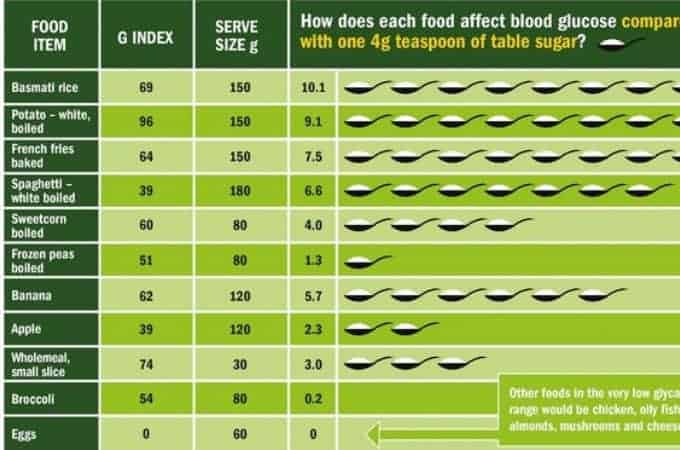
Forget this “whole grain is healthy” message. These are some of the most unhealthy foods out there! Grains are incredibly high in carbohydrates (which turn into glucose by the body). Modern grains are not like our ancestors ate.
Modern wheat, in particular, has been bred to be higher in starch, knee-high so that it is easier and cheaper to harvest, to be disease resistant (and thus have a long shelf life). It is also sprayed with pesticides and fungicides which affect our gut immunity and gut health.
If that wasn’t bad enough, milling and processing grains remove most of the nutrients. Wheat flour and white rice, amongst others, can be bleached with various chemicals, then is fortified with artificial nutrients. Wheat contains gluten, gliadins, amylopectins, and other proteins which cause leaky gut syndrome.
Additionally, wheat consumption is also associated with memory loss, arthritis, T2 diabetes, depression, heart disease, and Alzheimer’s. By living grain-free, you will be amazed at the health benefits including weight loss, reduction of puffiness around the face, heal your gut, absorb more nutrients, and feel amazing.
To avoid the sugar roller coaster of wheat, rice, pasta and grains. Swap out these starchy side dishes for a nutrient-rich option instead.
3. Sweets and Confectionery
Sweets are incredibly high in added sugar (quite possibly the worst food on the planet!), high fructose corn syrup, colourings, flavourings, and preservatives. They offer ZERO nutrition and cause tooth decay.
For a quick sweet treat, go for dark chocolate or berries as a healthy alternative.
If you are really craving a dessert, particularly when you are making the swap over to a keto lifestyle, try one of these delicious low carb desserts with no added sugar. They are still meant to be enjoyed as an occasional treat, but they aren’t nearly as harmful as your standard dessert.
4. High Fructose Corn Syrup (HFCS)
Fructose is not metabolized the same way as glucose is. Glucose can be metabolized throughout the body, but fructose is metabolized in the liver. Fructose causes visceral fat (that dangerous tummy fat that surrounds your organs) and raises LDL and triglycerides (potent predictors of heart disease).
It is used by the food industry as a cheap ingredient with zero nutritional value. It also has a relatively high sweetness at 1.7 x glucose. Food manufacturers try to hide High Fructose Corn Syrup, so it may appear on the nutrition panel as:
- Corn syrup
- HFCS
- Glucose-Fructose
- Isoglucose
- High Fructose Maize Syrup
Sneaky, right? Whatever you call it, high-fructose corn syrup is definitely high on the foods to avoid list.
5. Snack foods
These are your classic junk foods like pretzels, potato chips, wheat puff balls, corn chips, or microwave popcorn. Disregard the marketing terminology on the boxes and read the labels and most snack foods are high in carbs, wheat, sugar, colours, preservatives, trans fats…etc.
Instead, make your own snacks that are both cheaper and healthier. Sadly commercial snack foods are rewarding (short term), but they are packed with unhealthy ingredients that both increase our appetite and are addictive.
You can find healthy snack ideas in the 50 keto snack list.
6. Seed oils
This may seem like an odd option for foods to avoid, but there’s a very good reason it’s here. We have been told for so long to avoid cholesterol and to use seed oils such as canola, sunflower, soybean oil, corn oil, and other seed oils. However, these oils are high in artificial trans fats and Omega 6 which causes inflammation throughout the body.
Don’t believe me? Just watch the video below to see how canola oil is made, extracted, bleached, boiled, and refined. Then, all the waste products are sadly fed to cattle! Like that’s a good thing!
Instead, reach for healthy fat oils such as avocado oil and olive oil.
7. Sugar
Sugar in any form – is sugar! No matter where the sugar comes from it will raise your insulin, increase your appetite, stop fat burning and increase fat production and affect your cholesterol profile.
Don’t make the mistake of thinking that “healthy alternatives” such as honey, dried fruit, maple syrup, or agave (90% fructose so is actually just a natural HFCS) are any healthier. The body sees it as…sugar.
Yes, there may be a small amount of micronutrition in these compared to sugar, but many people tend to go overboard on them thinking they are a healthy alternative. The small amount of nutrients they contain is not enough to outweigh the damage sugar does to our bodies.
Need more convincing? I have an entire article with 30 proven reasons why sugar is firmly on the foods to avoid list.
8. Processed Meats
You may be surprised to see this on the foods to avoid list, but let’s talk about why. First of all, read the labels of the meat products you buy. Ultra-processed meats such as long life cold cuts and ultra-processed deli meats contain nitrites and nitrates which are controversial as the research hasn’t come to a clear conclusion. To be safe, buy meat that is unprocessed and fresh.
If you do want meats such as bacon or salami, always choose a brand that has the fewest ingredients. Buy the products which have the highest meat content, for example, sausages should be at least 85% meat.
Many of the studies done on processed meat have not made the distinction between hot dogs and roast ham carved from the bone. They do not also take into account the damaging oxidised french fries served alongside and the high sugar ketchup.
A better choice is to cook some lean meat like chicken or steak and enjoying leftover slices as a snack, rather than buying processed, chemical-filled versions.
You may also be wondering if grass-fed meat really better? And is it worth the money? That will be up to you and your financial circumstances. But buy the best you can afford, living low-carb really doesn’t have to cost any more. In fact, it is cheaper than fast food and eating out.
9. Breakfast Cereal
Yes, breakfast cereals are definitely another contender for my foods to avoid list! Read my entire post on cereals for more info. Simply put, if you can understand what is wrong with cereal, you will understand what is wrong with modern food production as a whole.
Essentially, companies turn cheap grains into socially acceptable cereals, packed with added sugar and fortified with subpar minerals.
10. Low-Fat Foods
When fat is removed from products, something is added back in—typically fillers, sugar or HFCS. This is to give the low fat version (or lite version) texture and taste. So low-fat products are almost always higher in sugar and carbs.
Look at the carb content of regular cream cheese 2%-4% compared to low-fat cream cheese, which is 7%-10% carbs. By removing the fat, you also remove the fat-soluble vitamins such as Vitamin A, D, E, and K. The same is true for yogurt, cheese, or cottage cheese, to name a few examples.
Fat is our friend! It makes you feel fuller for longer. Good fat also improves our cholesterol profile, and good fat is nutritious and necessary for good brain health.
10 Best Foods To Eat (and some easy healthy recipes)
Okay, now onto the good news! There are so many nutritious foods out there that can benefit your energy levels and help you along with your weight loss and health journey.
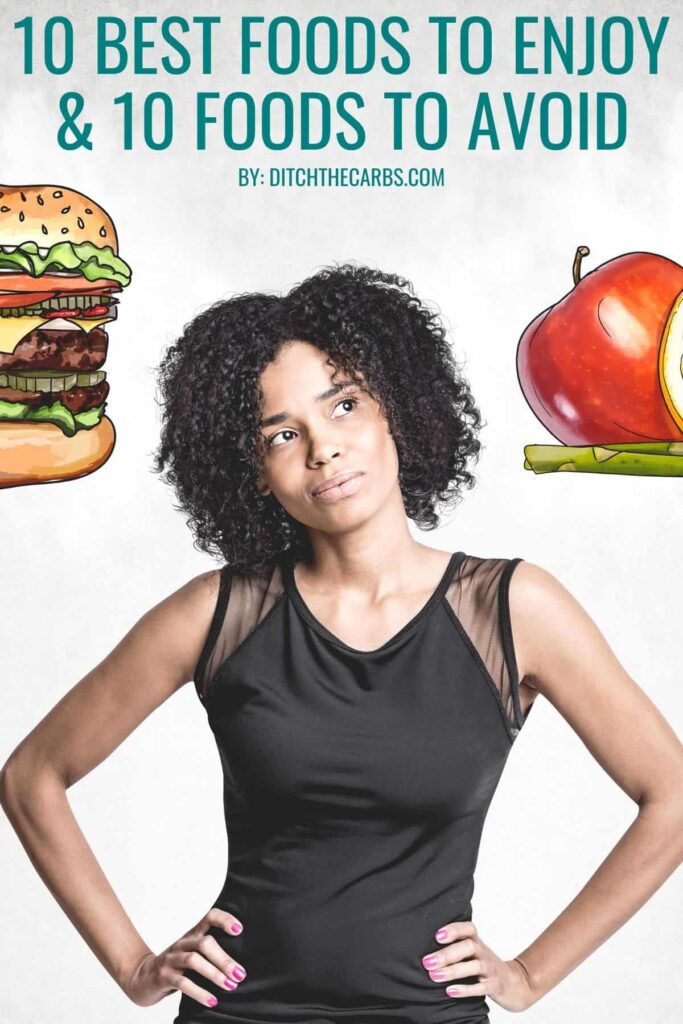
1. Oily Fish
Check the nutrition labels and you’ll see…oily fish is incredibly high in Omega-3 fatty acids which helps reduce inflammation, improves brain function, heart health, skin health, and joint health.
I highly recommend you eat oily fish such as salmon or tuna twice a week.
2. Eggs
I eat 3 eggs most mornings for breakfast. They are little powerhouses of nutrition, quality protein and incredibly filling.
The limit on eggs has been relaxed (or even removed) by many heart associations around the world since the science has been updated.
“Saturated fatty acids have a greater effect on blood cholesterol levels than dietary cholesterol” … “If dietary intake of cholesterol is low, the body increases production and absorption.” … “Furthermore, increases in dietary cholesterol might increase cholesterol removal from the body through the reverse cholesterol transport pathway”
They are “nature’s multivitamin” and contain almost everything required such as:
- protein
- good fat
- vitamins A, B2, B5, B12, D, E
- choline
- zinc
- folate
- selenium
- calcium
- iron
- potassium
- manganese
Eggs also contain choline which is essential for cell membrane structure, methylation, a precursor for the production of the neurotransmitter acetylcholine. Choline can protect the liver from certain types of damage and reduces levels of homocysteine (raised levels are linked with cardiovascular disease).
So start eating eggs again, and plenty of them. They are the most nutrient-dense foods on the planet, and so versatile.
3. Meat
Unprocessed meat is packed with iron, quality protein, and healthy fats. What’s not to love? Meat, and in particular organ meat, is incredibly nutritious. Red meat contains Vitamins B3, B6, B12, iron, protein, fat, zinc, selenium.
Meat is also ZERO carbs which means it helps to promote stable blood sugars. Many traditional cultures existed pretty much on meat and fat alone. Eating meat is one of the most nutritious things we can do for our health and vitality.
4. Butter
Poor old butter has got an undeserved bad reputation. It is full of saturated fat, so when the myth about unhealthy fats and cholesterol myth is perpetuated, poor old butter is off the menu.
Well, start eating it again. Saturated fat is good, as long as you are eating low carb. Butter is full of nutrients and vitamins. Butter is made from churned cream, and maybe some salt. That’s pretty much it.
Don’t get butter confused with margarine, which is made from vegetable oils. These oils are often hydrogenated (to extended the shelf life and make liquid oils spreadable) and contain a number of colours and emulsifiers.
Margarine and ultra-processed seed oils are easily oxidised and inflammatory. Throw them all n the garbage today.
Butter? Well, it just makes everything taste good.
5. Vegetables
We all know vegetables are good for us. They are high in fibre, antioxidants, and phytonutrients. Try and opt for more leafy green vegetables and less starchy root vegetables.
Add as many low carb vegetables into your meal as you can. Serve with fat such as butter, sour cream or soft cheeses to absorb more fatty vitamins. Your children will eat more vegetables too when butter or cheese is on the table.
6. Nuts and Seeds
Nuts are a great healthy diet snack. These guys are little bundles of fibre, vitamins, and trace elements, especially zinc, magnesium and selenium.
Some nuts are higher in carbs than others, so if your weight loss has stopped, just be careful which nuts you are consuming. I recommend you avoid cashews as they are the highest in carbs. And ALWAYS portion control your nutty snacks.
7. Coconut Oil
This oil a wonderful source of medium-chain triglycerides which help produce ketones, energy and some claim to aid weight loss. Coconut oil contains lauric acid which is anti-fungal and antiviral.
- Vitamin E
- Polyphenols
- Plant sterols
- Lauric acid
- Palmitic acid
- Myristic acid
- Monounsaturated fats
- Polyunsaturated fats
- Saturated fats
- Medium-chain triglycerides (MCT)
Studies are now linking coconut oil with the prevention and improvement of Alzheimer’s disease.
8. Full Fat Dairy
Full-fat dairy is high in calcium, healthy fats, and fatty vitamins (A, D, E, and K). Remember from the foods to avoid list…don’t go for the low-fat versions as they are high in carbs and low in nutrition.
But remember, if you drink a lot of milk, remember the carb count soon adds up. If you drink milky coffee, you may want to avoid such high volumes of milk and start to make creamy coffee instead.
9. Natural Yoghurt
Real talk: gut health is incredibly important. 95% of your serotonin (happiness hormone) and 70% of the cells that make up our immune system are found in the gut. Modern foods, alcohol, stress and preservatives all affect our gut health.
We are the first generation to grow up with preservatives in almost ALL processed foods. Preservatives stop bacteria from forming in food, so what is it doing to our gut health?
The solution? Eat more natural unsweetened yogurt! It is full of live bacteria, which is a fabulous way to restore the flora in your gut. Eating whole foods and unprocessed foods also gives a marked improvement. Additionally, after taking a course of antibiotics, consider taking a probiotic to restore the good bacteria.
10. Berries
Berries are such a wonderful fruit. Lower in carbs and fructose than other high sugar fruits, but incredibly high in antioxidants, fibre, vitamins, and minerals. They can be added to smoothies, grain free granola or serve with natural yogurt. Or just pop a handful in your mouth!
Foods to Avoid: How to Put it Into Practice
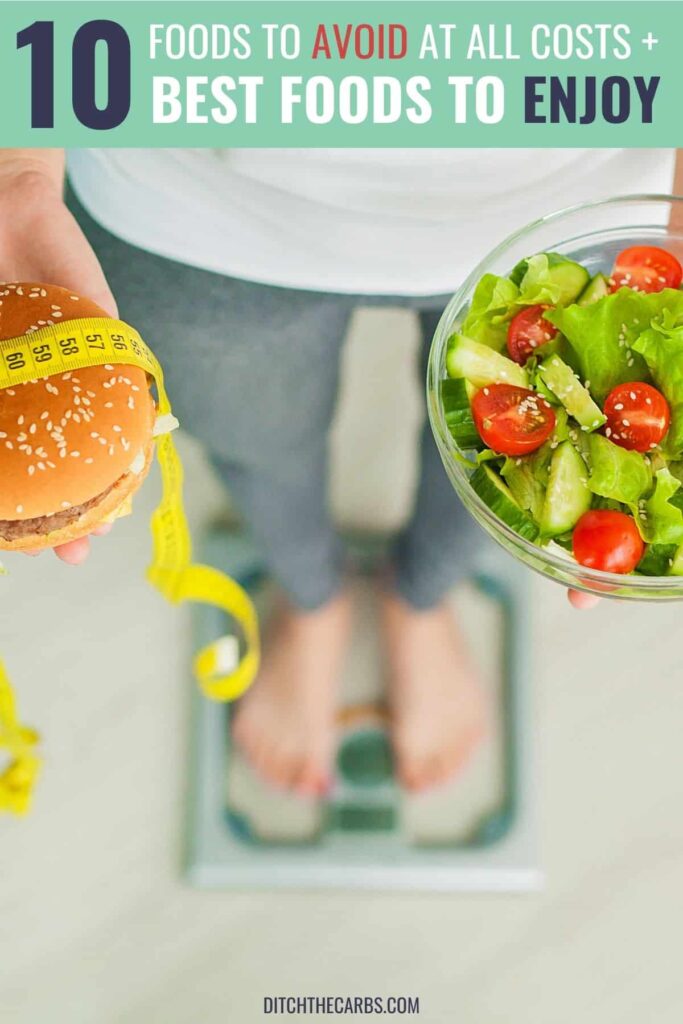
“But giving up carbs, wheat and junk is so hard and can be so expensive…..
I absolutely agree, it is hard to begin with, and yes it will take time to adjust, find new recipes, and to think differently. However, once you start, you are making a real change for you and your family’s health.
Who wants to be sick, overweight, unhappy, and at high risk of serious health issues? Who wants an old age where your health is stopping you do the things you want?
We have choices in life, we either put up with things, or we change. Just start eating more of the good foods, and less of the bad foods. Pick 1 or 2 items from the foods to avoid list, and pledge never to have them again. Then when you’re Ok with that, decide on another and so on, and so on.
And look at how far you have come, not how much more you should be doing. Be proud that you are trying.
The Cost of Low Carb Eating
Concerned about the cost of going low carb? I’ve got 100 tips and tricks to make low carb eating cheaper. But, the cost may not be as high as you are thinking. I recommend you check out this post on how much low carb actually costs. It has some great cost comparisons for low carb and high carb meals.
“Do what you can, with what you have”. I think we all agree that organic, grass fed, free range food is best, but realistically, that is out of so many peoples reach, especially the people who need help the most.
Don’t let this ‘ideal way of eating’ stop you. Go and buy the cheap eggs, the cheap cuts of meat, the fatty meats (which are actually the healthiest), go to the cheap vegetables shops, stock up at the butchers and shop around.
You will also save $$$ by not buying any junk food. No more cakes, biscuits, crisps, muesli bars, bread, soda, sweets and pizzas. No more takeaways. A McDonalds family meal easily costs $30 for a family of 5, for $30 I could buy a roast chicken, plenty of vegetables, and have enough money leftover to make a lowcarb dessert or some dark chocolate.
Invest in your health, and prevent big medical bills in the future.
Some of us pay for life insurance, so why not invest as much in your health?
It’s hard to lose weight, but it is so much harder being overweight. You’ve got this!
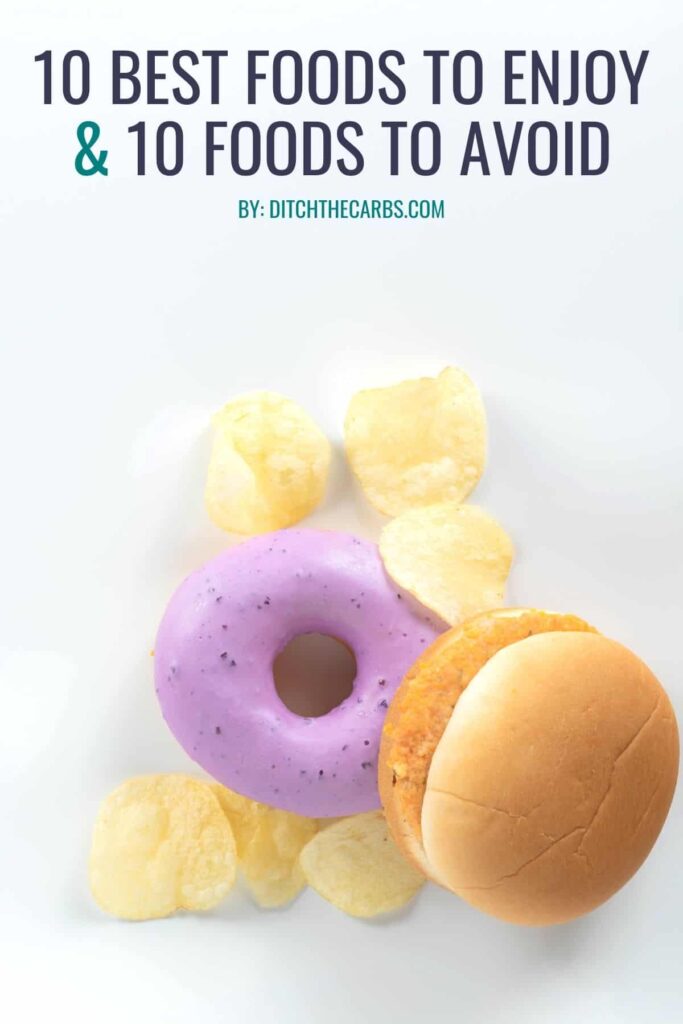
What if you could actually take control of
your health in just 10 days?
It’s not your fault you can’t lose weight as a woman over 40 even though you’ve likely tried literally everything. Your metabolism probably feels broken and your hormones are likely all out of whack.
But you can fix it all with ONE simple change: eliminate sugar. We make it super easy with daily lessons teaching you the science behind what makes us gain weight in our midlife and beyond! Are you ready to get started now?






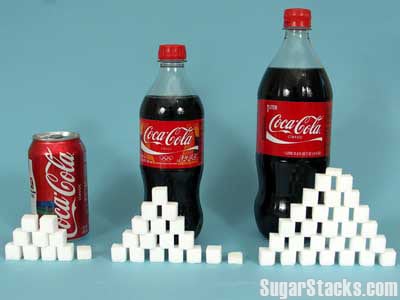
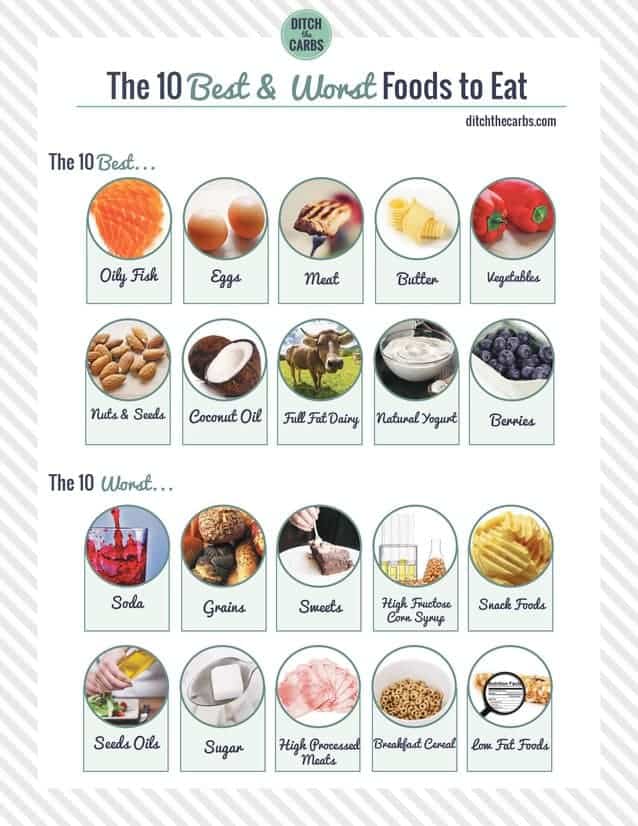







Libby THANK YOU SO MUCH for all the fabulous information you keep us updated with.
Lorraine
Thank you so much Lorraine, getting comments like yours makes it all worthwhile x
I cant eat eggs or fish so what would be a substitute for them?
Is it all types of fish that you can’t eat? As for eggs, some people have successfully used chia seeds in some recipes. Meat and dairy would give you the protein you need. Chia and flaxseeds are a good option for omega 3’s.
Hi Libby-I am on the road to making dietry changes for weight loss and better health. It is quite a daunting task as there is so much conflicting information on the internet. However, I find your advice and guidelines very helpful and practical so I am sticking with it. Thanks for the help. I will let you know in a month’s time how I am progressing.
You can use combining amino acids to help get more protein. See if you can find a copy of “Diet for a Small Planet” which explains the idea of protein complementarity in great detail. It also has quite a few recipes, but it does tend use noodles, etc in the recipes.
What a great little video too, loved the entire article but I am pleased I don’t use canola oil after seeing that!
So in moderation fresh fruits, extra virgin olive oil, legumes, white rice (Asians live on this for a long time and didn’t have problems until now).
Yes they lived on rice and didn’t have a problem until now, that’s the crucial factor. They were fit and active and lived on real food not bombarded with processed carbs everyday. real fresh food that keeps your blood sugars stable and in the healthy range (not spiking then crashing) and you can’t go far wrong. 🙂
rice is EXTREMELY HIGH IN ARSENIC. does not matter if it is organic, white, brown etc….
Oh Dear I just went and bought Rice Bran Oil as well as rice bran cooking spray because another quit sugar site said it was ok! Now I’m confused, your saying no seed oils! ?
A small comment about Canola (or Rapeseed Oil if you like).
Compared to any seed oils, the Omega6 content of Rapeseed is much lower than Omega9 (monounsaturated) so if you can find COLD PRESSED rapeseed oil it’s in fact very healthy!
The off-the-shelf Canola oil you find at the supermarkets is highly processed and it’s equally bad as any other omega6 seed oil.
Rapeseed is terrible for you. The reason it became the first GMO crop (known as Canola) is because it contained erucic acid which causes lesions on the heart muscle. https://www.naturalnews.com/034733_canola_oil_rapeseed_food_labels.html
You lost all credibility the moment you cited naturalnews.com
The cost of low carb eating or buying better food is very small compared to the cost of a heart attack, stroke, and diabetes.
All I can say is keep it up Libby I have passed your website details to many people even the nutritional GP I go to who started me off on a LCHF (ketogenic) diet with a few recipies. Zucchinis and Cauliflowers are the two most used vegetables and all margarine has long gone. Omega3:Omega 6 ration has improved significantly and cholesterol is down as well as the weight. So thanks
I thought eating LCHF was gonna LOWER my cholesterol…so I got off the statins and started my journey. Just got my blood test results and my numbers are SKY HIGH!
TOTAL: 301
HDL: 236
LDL: 213
A1C: 6.0
Now I’m scared n confused!!! Been faithfully eating LCHF since May 2016…what to do???
Any n all advice greatly appreciated ❤️
What about your triglycerides and HbA1C, have they gone down? They are said to be the most potent predictor of heart health and carb tolerance. Read “Cholesterol Clarity” – Jimmy has written on scores of blood tests. I recommend it to anyone concerned.
Hi: What should We Eat Today? Years ago We were told Don’t Eat This And You Can Eat This! Have The Experts finally Come To An Agreement What Is Good for Us? Seems Like If We Ate what Our Grand parents Ate , We Be Better Off. good Old Natural Food. Not with All The Junk Put In them Now! Yes This Is My Own Opinion .Amen..
ditching the carbs is a terrible idea. You should ditch the fat.
Fat has 9 calories in a grams, promotes slow metabolism and is the least filling per calorie.
A good macro ratio for weight loss is 60-65% carb, 25% protein, 10-15% fat
Interesting if this is what you follow, that you ended up on a low-carb site! For the rest of us who have followed the current flawed food pyramid, all it has done is ruin our health, given us insulin resistance, metabolic syndrome and increased our appetite. You may wish to read this from the President of the World Heart Federation. Carbs are harmful, fats protect us”. You heard it here, from the man himself 🙂